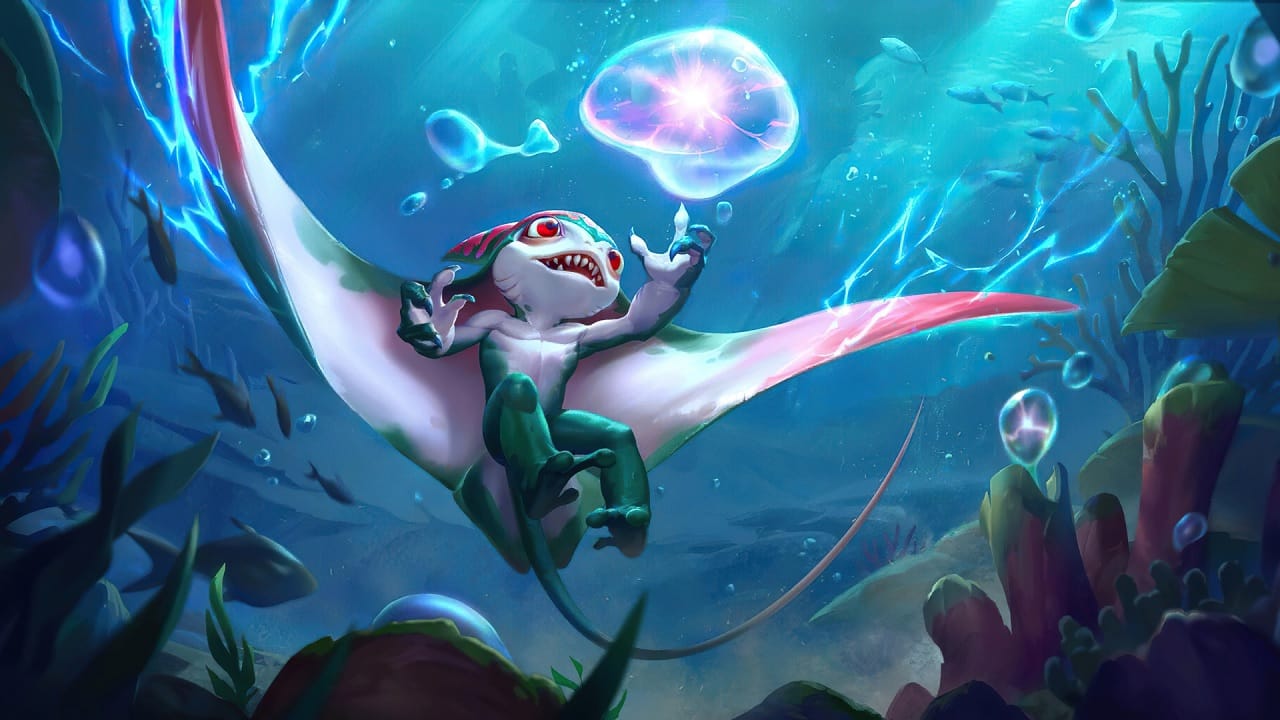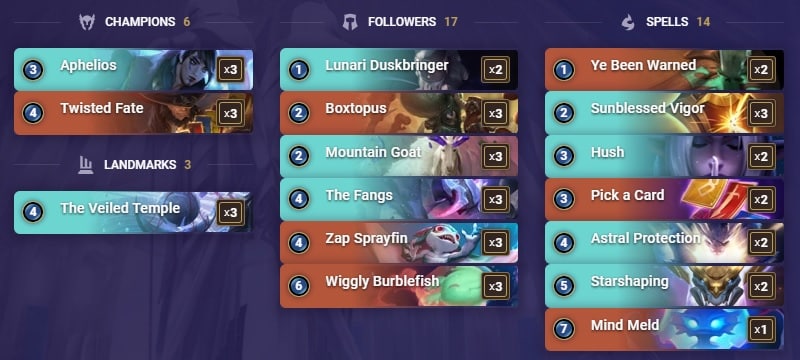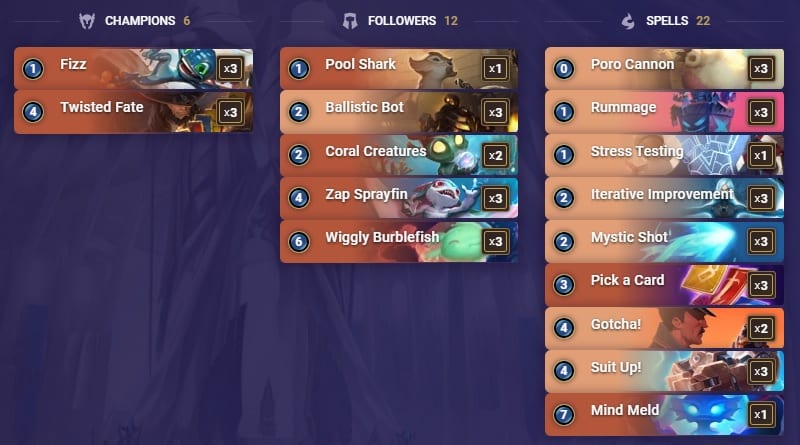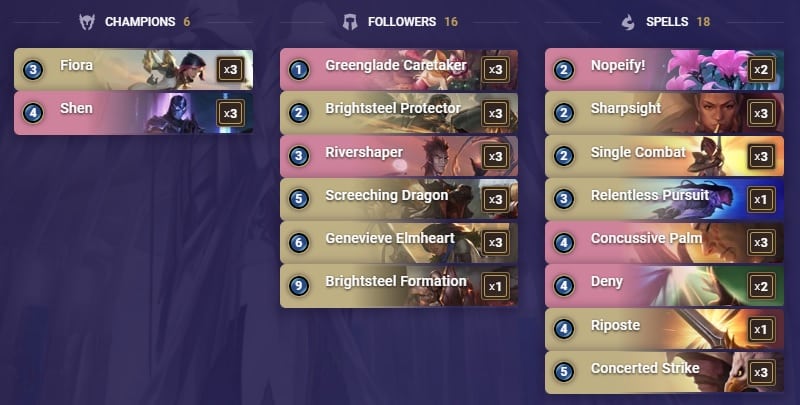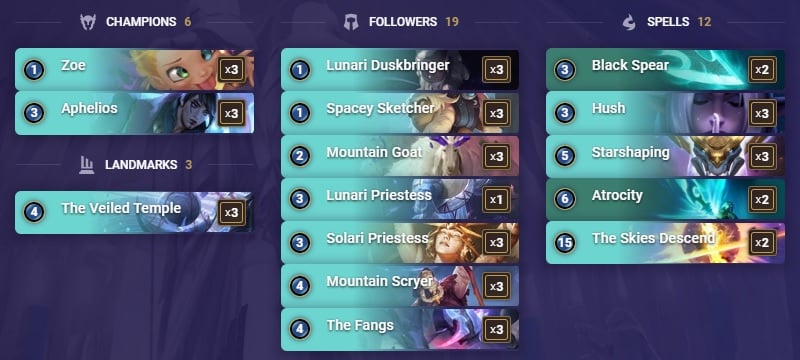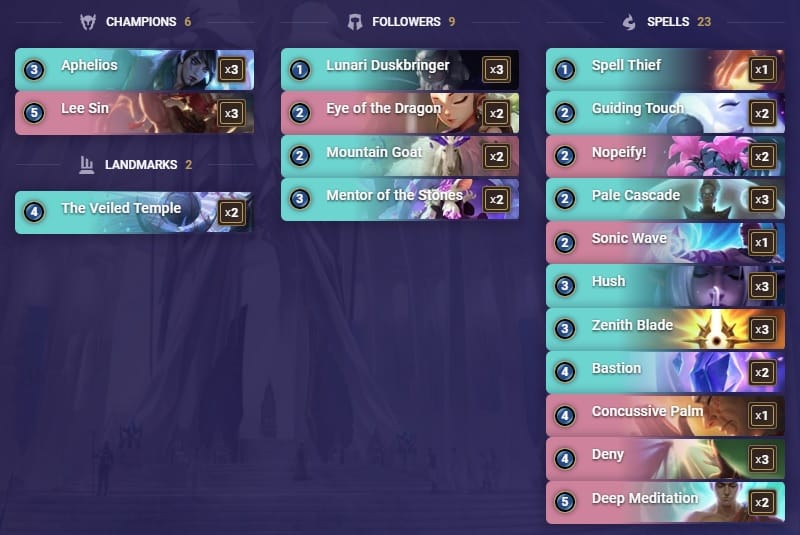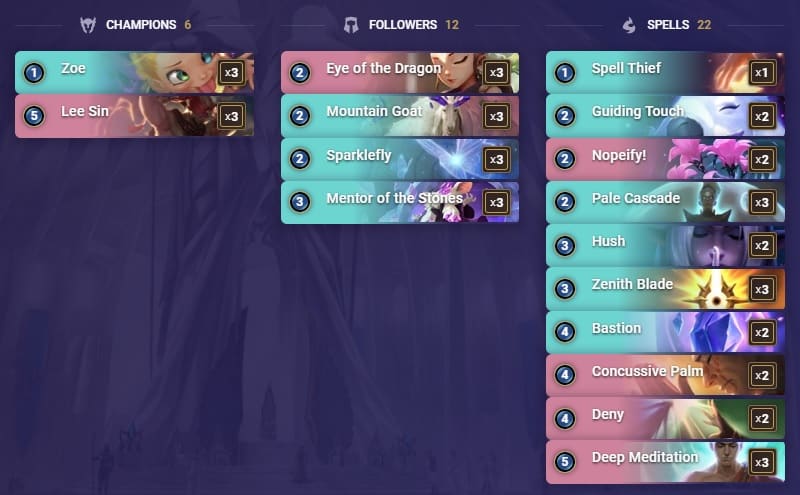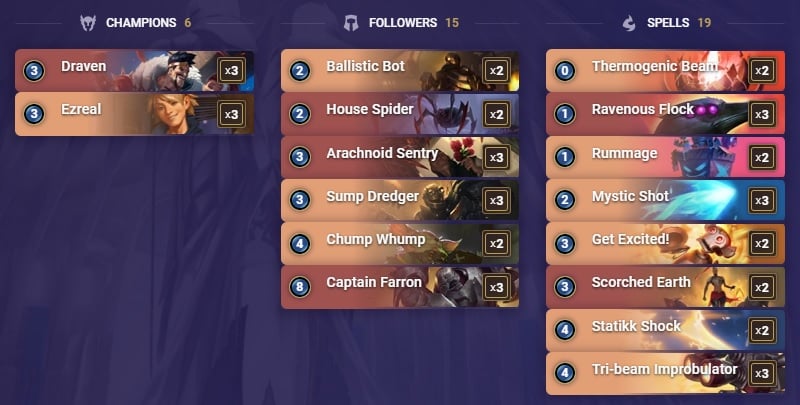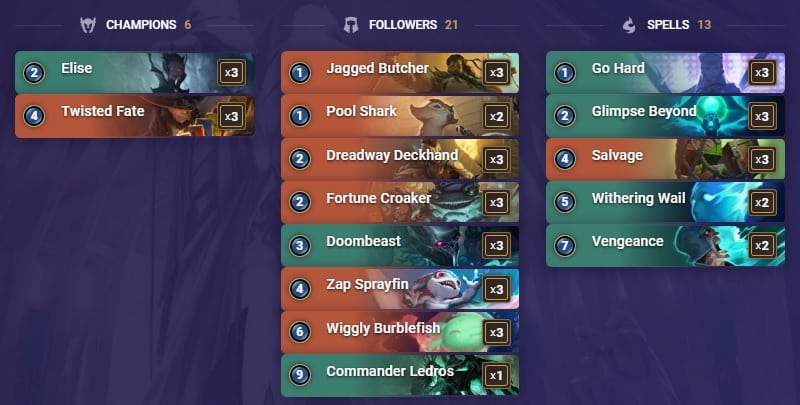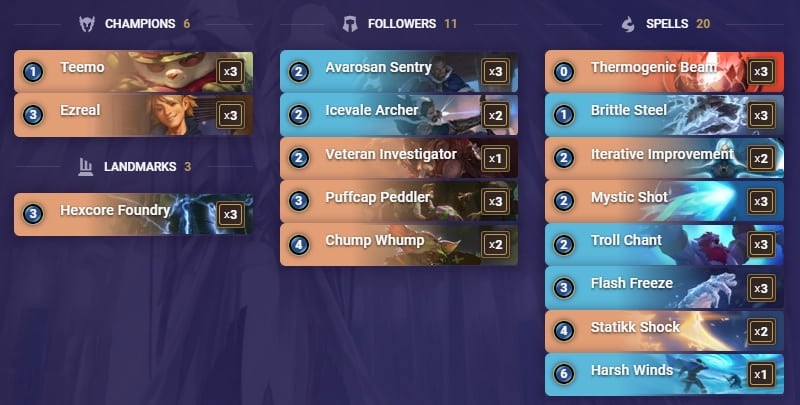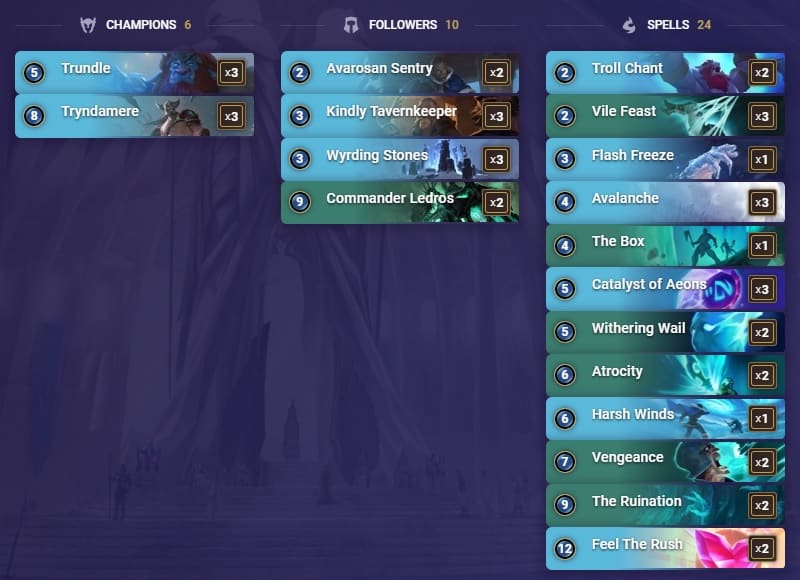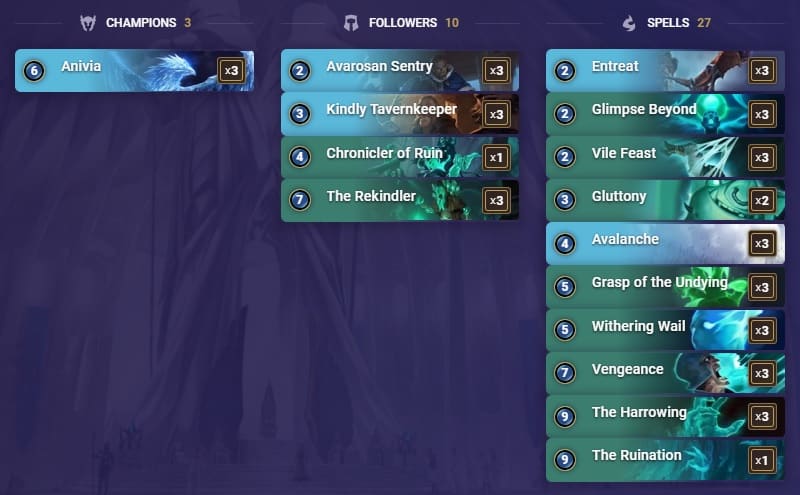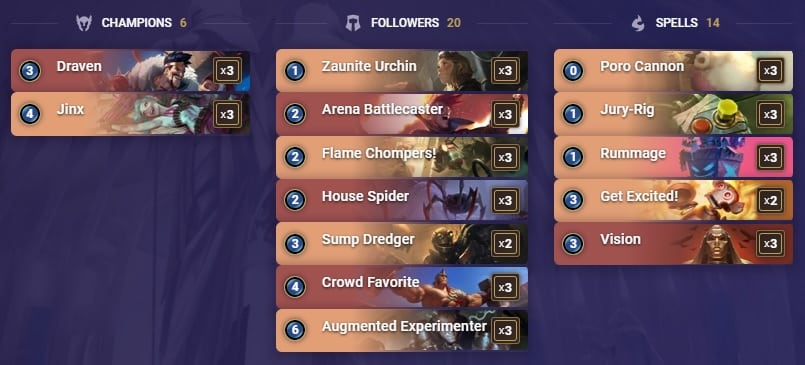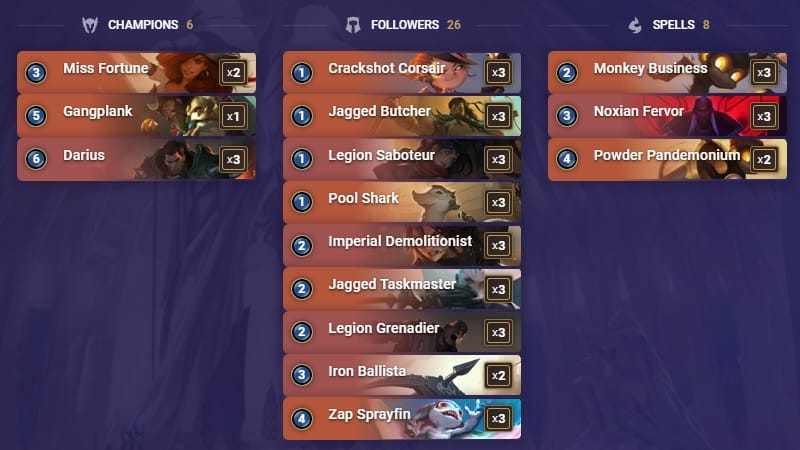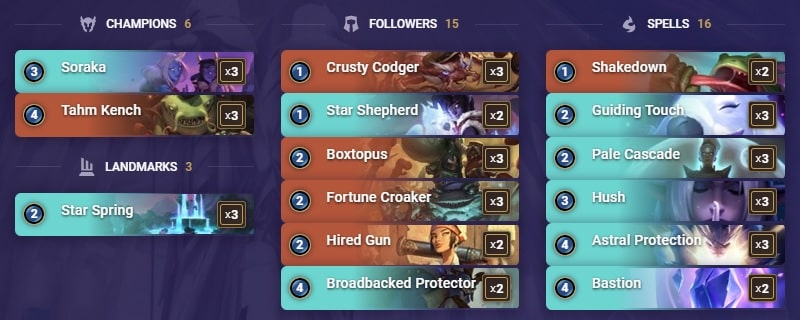Welcome to TLG’s latest meta snapshot for Legends of Runeterra, a series in which we give you our insight on the finest decks in the higher ranks of the ladder.
Every Monday, we discuss the decks that are part of the week’s meta and rate them on a scale of 1 to 5 stars. We also look at the evolution of said decks’ ratings across weeks and draw conclusions regarding the current state of the game, all of this so you can delve into your own ranked journey with a head start.
This week, Tier 1 should be treated as the S Tier. The two decks inhabiting it, Aphelios-TF and Fizz-TF, are miles ahead of the rest of the field. It seems as if they will dominate the ladder until the next expansion is released in a few weeks’ time. This means we’re about to see some cheeky counterplay take shape in the meta, so strap yourselves in for the wild ride, whichever side you choose to take.
Speaking of counterplay, our deck spotlight features a close look at the deck spearheading that movement: Teemo-Ezreal.
If you have any questions, feel free to drop by our Discord. Best of luck on your climb!
Graphics: WellMax81
Editing: Crixuz, Den, Wusubi, Sebodunum, Ultraman
EU Consultants: CastMin, Dartill, Kuvira, Pespscola, Zezetel
NA Consultants: IPingUListen, RattlingBones, RiceFT, Zenaton

CIBQEAQGDITAEAYGA4IQKAYJLRRNSAO3AHOQCAQCAIDACKYEAMES2SKUKUAQCAQGFI
Difficulty: Hard
For the first week in our snapshot, Aphelios-TF is busting down the door and taking the #1 spot. Despite not having a refined list of 40 cards, this deck already seems to be a true juggernaut, which can only be taken down by a potential nerf.
Powered by two of the best champions in the game and The Veiled Temple, this deck can find multiple win conditions and will control the pace of a game from start to finish. The deck took inspiration from the Bilgewater package of Fizz-TF, the best deck from last week, and is seemingly impossible to exhaust in a resource war.
Aphelios is the main engine in the deck and the main reason behind its flexibility. The landmark takes care of tempo, giving you more mana than your opponent while buffing your units. Twisted Fate comes in as the last piece of the puzzle, helping either in a defensive role with the Red or Gold cards, or providing some more cycle with the Blue one.
While it isn’t as important to evolve TF as in Fizz-TF, the attention that Aphelios draws to him and the edge the landmark builds over time makes TF look less threatening to your opponent, giving you more time to level him up to devastating effect.
The deck is brand new and potential counters are still to be discovered (Teemo-Ezreal is looking like the best option right now, alongside very aggressive decks), this archetype is everywhere on the ladder featuring a crazy 22% playrate and looks locked in as the top deck of the current meta.
CICQCAQEAMAQGBQRAIAQIAJUAMBQIBINCICAEBQ2EYVS4AQBAIDA4AICAQDAEAIDAQMQEAQGBEVA
Difficulty: Moderate+
Fizz, the Elusive fish, still strikes fear into his opponents as a hard-to-remove win condition that only fears AoE and can outlive even those easily thanks to an early Suit Up! In some matchups, the latter alone will win you the game. Ezreal-Draven’s inability to trade or kill Fizz means they’re forced to accept multiple instances of damage each turn, meaning they’re unfavoured in the race to Nexus destruction.
Moreover, Fizz isn’t even the biggest threat this deck has to offer. Twisted Fate is an amazing powerhouse, able to sometimes level-up in 1 turn thanks to Pick a Card and Rummage. This potential to level-up so quickly is both a counter to decks that lack the possibility to remove TF instantly (mostly Targon decks) and a great pressure on Anivia and FTR decks to use their removal, giving you the opportunity of punishing them with a crazy OTK from your assembled army of Wiggly Burblefish.
In this way, the 9 damage for 0 mana that they represent is even a problem for their so-called counters that rely on one AoE to do the trick. The opponent will have questions racing through their mind: Do I let TF level-up? Will Fizz crush my Nexus? Is the Ballistic Bot going to slowly erode my defenses? Should I commit my mana to an AoE and accept that I will lose if my opponent has more Burblefish?
None of those scenarios are enjoyable for the opponent to consider, and as the Fizz-TF player, you’ll often just “Checkmate” an opponent into forcing them to remove your board, only for you to get 13+ damage in soon after.
In the end, this deck is all about forcing your opponent into making mistakes and punishing them. This can be done through Mind Meld, a TF leveling-up in one turn, Fizz denying spells, forcing an AoE on Fizz so you can then play Burblefish... Be patient and advance your pieces until your opponent is out of options and is forced to play right into your trap!

CICQCAQCAUBAEAABBIBAGAAGBYBQCAAJDIWQGAICCMQCWAQBAEBDCAIDAIKACAYBAAKSKNA
Difficulty: Moderate
Demacia lost its beloved Plaza and tons of popularity in the process, but Fiora is still standing strong representing the region. Alongside her best friend Shen, the deck has once again found a way to stay one of the top decks in the meta.
The nerf to Hush was great news for the deck, and even though the card still finds its way in most of the Targon decks on our snapshot, its 3 mana cost still helps Fiora-Shen in that it demands more mana from the opponent to answer a possible barrier or Sharpsight.
Another great thing from the patch is the return of slower decks like Anivia or Go Hard for example, which are giving the Ionia region some hope to shine, as Nopeify! and Deny return as good tech choices again.
While the deck relies on the same old concepts, like the ability to control trades via the Challenger tag or using Single Combat and Concerted Strike, these are what make the deck good in the current environment. Champions like Twisted Fate, Aphelios, Zoe and Ezreal all have a game plan which focuses on survival and abuse of their passive abilities, which Demacia can deny by forcing them into combat.
This simple ability to remove the important pieces of our opponent’s game plan is enough to keep the deck relevant as of now. And even though Fiora isn’t winning so many games anymore, her presence is enough to enable the other units in the deck to pressure our opponent and force them into playing a game we’re very good at: trading.
With a favorable matchup into Fizz-TF, the return of SI decks and the Challenger tag being one of the best keywords against Targon, this deck still looks to be a popular one on ladder or during a tournament, and should please all the players looking to fight with stats more than synergies.
CIAQWAYJBFEUYVCVKZOGBWIB3MA52AICAEBQSAQCAECRSIQBAEBQSSY
Difficulty: Moderate
Aphelios and Zoe are the most splashed champions in the current meta, both being great tools to generate value and guide a deck into the late game. Naturally, a deck featuring both champions is a value machine that scales through the different stages of the game nicely using generating tools along the way. You get help from Mountain Scryer and The Veiled Temple, since both cards are able to generate a lot of tempo if they’re able to stay on the board.
While this deck looks like a Midrange one at first, it probably is the best late game enforcer if given the opportunity to do so. The idea is to force the opponent into a defensive position, so we can then abuse our Celestial generation and just make the problem get bigger and bigger. Atrocity is the finishing blow, often used on a Celestial unit with Spellshield, so the opponent can’t easily interact with it.
Aphelios replaced Diana in the build to further strengthen that feeling, and while Diana might be missed sometimes when we want to remove an important champion on the opposing side of the board, Calibrum has replaced her in that removal task and the other Moon Weapons offer much greater flexibility in different situations.
Because of the very fast and tempo-oriented state of the meta, this build looks to be most fragile one in Tier 2. The very Invoke-focused nature of the deck can get outpaced by other decks capable of setting-up their synergies faster.
It also doesn’t help that Aphelios-TF is capable of almost the same sustain ability, but with a better defensive package, making it a more all-around deck for ladder. In tournaments, though, this deck could find a lot of love from players, as it can be paired with Fizz-TF and represent a feared combination instead of bringing an Aphelios-TF that will likely get banned away.
Lee-Aphelios version
CIBQCAICGEAQEAQGAUBQSGZDJFK5SAIDAEBQEFACAIBAGCIFAMERGKJTLTNQCAQBAMESUAQCAICQQ
Lee-Zoe version
CIBAGAQCAMDASBQDBEERWIZIFFOAIAIBAIYQCAQCAUAQGAQUAMBQSEZTKUAQCAYJFI
Difficulty: Moderate-
While Lee Sin doesn’t look like the best option for ladder, and his pairing with Zoe is preferred for now, the blind monk has once again found a very powerful ally in Aphelios. The deck still keeps the same fundamentals, but varies the way it controls the pace of the game and gets to the Lee OTK.
Zoe is used as a way to level-up Lee Sin faster, as she generates spells and gives us flexibility to answer the opponent through Celestial cards. She is a better up-tempo card that allows the deck to play from Turn 1 and keeps the opponent busy while we are setting-up our later combos.
This faster approach looks to suit the meta better, as most decks right now are capable of snowballing in their development if we don’t interact with them in the early turns. Zoe serves as a distraction and disruption that needs to be answered.
Aphelios plays the role of an all-around support, being able to summon Eye of the Dragon or Mountain Goat with Crescendum. Furthermore, Infernum can grant Overwhelm to Lee Sin. However, Aphelios is much slower and therefore plays into the deck’s pre-existing weakness of suffering a lot from an explosive start from the opponent.
This version appears to be a more polarized option, helping to build an even greater edge in favorable matchups, but increasing the slow tendencies of the deck in the unfavorable ones.
While Fizz-TF reduced the deck’s popularity a lot lately, the return of slower decks since the patch and Aphelios making Aggro decks very hard to play on ladder is fairly good news for Lee Sin to hear.
CECACAQDBEBQCBBEEY2AGAIDCQXDGAIDAQIQIBIBAQARWHZHHIAQGBAFAEAQGNYBAMBQ2AA
Difficulty: Moderate
The nerf to Captain Farron seemed like it wouldn’t be so bad for the deck, but combined with the healing potential the Targon region possesses, Ezreal-Draven is looking like a tournament deck more than a ladder one lately.
Draven is still a good champion, and his quick attack makes him a nightmare for Aphelios decks to block when he comes down on Turn 3. He usually anchors the board and builds up to a favorable position where we can leverage tempo and set-up a great attack turn. Our spells are then used to deal with opposing threats and we can snowball into the late game where Ezreal and Farron will come in and close the deal.
The problems arise once we’re unable to get in that position and we have to fight from behind. While we have a lot of spells to slow down our opponent, most of the current decks at the top of our meta snapshot can go for what seems an eternity before lacking cards to use their mana on, and our drawing potential only matches the card generation of most Targon decks at best.
At some point, we have to stop defending and try to go for the kill, which opens a window for our opponent to punish us if they can answer Captain Farron on the spot, usually creating a gap in mana usage that’s too hard to recover from.
Aphelios-TF is a good matchup on paper, as we can answer both champions with cheap spells and destroy The Veiled Temple using Scorched Earth. They also have no clear answer to an on-curve Farron or Ezreal staying in the back row. Having all of this go our way isn’t so common, though, and that’s why this deck is struggling to really take off in the current environment.
While Ezreal-Draven looks playable at the highest level, we’re afraid the dastardly duo might be losing ground as time passes; this could be the last week we have it in Tier 2. There’s the potential for some rising Aggro decks giving favorable matchups to this archetype, but we will have to see if that is the case.
CICAEAIFGE2QEAYGBAIQEAYFAYIAKAQGAQNB2JR2AIAQEBQJAIAQKAI5AEAQCBJB
Difficulty: Easy
Another TF deck, another good matchup into most Targon’s builds. This is the main reason Go Hard was able to remain played despite the heavy nerf to Pack your Bags. Less Deny and more Midrange decks to counter also helps, however the matchup against Fiora-Shen is terrible.
Still a threat to be reckoned with, the deck preys on other Burblefish decks and Ezreal-Draven, but falls short as a counter to the best decks in the meta, strictly because of the crazy power level of those S Tier decks. This notion can be strange to understand, but sometimes, despite having an answer for just about everything, the raw numbers are too big to be handled - and that’s the case for Aphelios-TF and Fizz-TF.
The reacquaintance of the player base with Anivia decks has also been damaging to Go Hard. They disrupt your game plan of pushing damage through early followers and finishing the job with a leveled-up TF or Ledros. A leveled-up TF is hard to achieve against Avalanche, while Withering Wail will always kill a part of your pressure in the middle of your attack.
Ledros can also arrive too late to stop the multiple Anivias from slowly shattering your Nexus (The Harrowing accomplishes this rather fast). Your only way out are well-timed Wiggly Burblefish and the effect of surprise against an overconfident opponent who thinks the game is over.
If Go Hard struggles to stand its ground against the top tiers, it’s still one of the best, if not the best, anti-Aggro deck out there. It handles with ease the likes of Discard Aggro, or GP-MF, and with the nerf to Plaza, it’s now able to easily deal with Scouts or Lucian-Hecarim. A change in the meta could push Go Hard closer to the top at any point.
CICACAYBAIAQGBAUAMAQCAIDDYCQCBAIDENSINADAEAQCCYBAMCA2AQBAQPTUAQBAEASUAICAQFA
Difficulty: Moderate
At its core, Teemo-Ezreal is a Teemo or Poison Puffcap-focused deck. You want to mulligan for Teemo and Puffcap Peddler to get your engine going. The deck deliberately plays cheap spells, allowing you to maximize your Puffcap generation.
Every Freljord-PnZ deck ultimately needs to solve the problem of limited card draw. Previously, this mainly came in the form of Statikk Shock or Progress Day! The introduction of Hexcore Foundry, however, has meant that the region pair has a new way to avoid running out of steam. Yet, given Foundry’s bilateral effect, timing its use is important.
Many players play Foundry in early turns, as a way to improve their bricked hands. This is usually a bad play, as you’ll allow the opponent to advance further. Rather, aim to play Foundry when the opponent has a hefty amount of Puffcaps in their deck or when you get to a certain turning point.
The turning point can be recognized by asking “If I play Hexcore Foundry now, and both players each draw one additional card per turn, who’s more punished by it? Is the advantage that my opponent gains from drawing one additional card much greater than the advantage I gain?”
This analysis will depend on the natural strength of the cards they can draw, the mana that they’ll have going into the next few turns (if their cards are all 10 mana and the game is at T5, you may safely play Foundry), the potential number of turns that they will destroy their Nexus from the extra card they draw (due to the Puffcaps), your health or ability to chump block, etc.
Basically, knowing when to play your Foundry is the toughest element of this deck. Whatever it is, the answer is nearly always not going to be Turn 3 and the landmark will mostly likely be played on Turn 5-8.
Teemo-Ezreal also has the ability to go faster or slower. It’s easy to understand how to go fast. Play Teemo on T1, Puffcap Peddler on T3, go face against an empty board and so forth. To go slow, you should understand that outside of Deep decks, no deck has the ability to remove Puffcaps. Knowing this, simply play a Puffcap Peddler (or two) and plan for the long game.
That means protecting Peddler, managing your opponent’s board so that it doesn’t go crazy, and not overextending (i.e. don’t empty your hand followed by playing Foundry early). Many decks don’t have a way to effectively deal with the Peddler.
Attacking means that you might be forced to exhaust your Troll Chants, but you don’t want to do that sometimes. Keep your Peddler alive and “turtle” your way to 80 Puffcaps in your opponent’s deck.
Lastly, the final component of the deck would be Ezreal. First, determine if Ezreal is ever coming out early. This will depend on, but isn’t limited to, whether the opponent can answer an early Ezreal, or if you need to answer Zoe. Next, Ezreal is often a great finisher for many decks.
For matchups that are going to be a little tighter, Ezreal will be your saving grace. The deck levels Ezreal easy; all of your spells target units and Icevale Archer is a 3 for 1 (it levels Ezreal, gives you an attacker or chump blocker and prevents your opponent from attacking for one turn). A leveled Ezreal in the late game can look at dealing 4-8 damage, which is very useful for closing the game.
See the deck spotlight below for further information on how we think this deck will fare in the current meta against the likes of Aphelios-TF and Fizz-TF.
CEBQCAIFFACQCAIMCQQSOMQBAMAQMAYBAEAQGAQDAEBBMBIBAUAQ6GI5EEBAEAIBAEVACAIFCM
Difficulty: Easy
Similar yet different to Anivia, FTR shares most matchups with its feathery counterpart - it suffers against Ionia and Deny decks, and although rarer nowadays, Fiora-Shen and Lee Sin still roam around, stealing free wins from your icy heart. Ezreal-Draven is the easiest foe to face, while the lack of Scouts after Plaza’s nerf definitely makes FTR feel better.
The game plan hasn’t changed and probably never will: ramp up and use Avalanche to keep the board in a reasonable state that won’t damage you too heavily before dropping Trundle to gain time and The Ruination or Withering Wail to handle your opponent’s aggression. Once all this is done, use Ledros/Atrocity or FTR’s double Overwhelm champions to finish the game.
However, with so many decks brazenly cheating the mana system nowadays, the deck finds itself in a hard situation each time it has to use an AoE to handle aggression - is it worth it, can I wait longer and will I be punished by Wiggly Burblefish?
While you should always ask yourself these questions, the answers might not please you: in most scenarios, your decision won’t matter as much as the ability of your opponent to punish the outrageous use of mana. Like, who needs to use mana? Seriously.
CIBAKAIBAMKBQHJSA4AQKAIDCQOSQMJWAEAQGBISAEBACBIPEA
Difficulty: Easy
The addition of Gluttony, the nerf to Hush and a good matchup into Fizz-TF had Anivia poised to be a contender after the patch, and some players consider the deck to be decent. In all honesty, we don’t have such high hopes for the deck, although we think it’s a fair Tier 2 archetype and a counter to some specific matchups.
The issue with the deck is the same as before, it lacks the flexibility in the way it can use its mana. Gluttony is a great addition, allowing the player to gain some stability in the most important phase of the game for them: the transition from having one Anivia on board to having a lot of them. But the card doesn’t fix the other issues the deck has, like the fact that it has to spend between 5 and 9 mana to get any good form of AoE done.
This isn’t ideal when the average follower in the meta costs 2 to 4 mana and there are plentiful Wiggly Burblefish swimming around at zero cost by the time we get to our comfort zone. The Ruination, still the only mass removal in the game, feels like it has reached its limit and almost any deck in our snapshot can efficiently play around it or force it out before investing seriously into the board.
As such, the deck is almost forced to develop Anivia on Turn 6 in order to start chipping away at the opponent’s board, and with the flexibility decks like Fizz-TF or Lee Sin are displaying lately, the opponent can set-up a lot of ways to punish this.
Lovers of the archetype shouldn’t shy away from playing it, though, as the deck can be one of the best when it gets going and we can start multiplying the Anivias. The switch to a very defensive and health-draining build, including Grasp of the Undying instead of the usual Catalyst of Aeons makes the deck great into everything that can’t generate resources and would rely on a very aggressive strategy.
CIBAKAIDA4ERIJZXAYAQIAIMDQTSQLIDAEAQGKABAECA2AIDAQJACAIBAQ2A
Difficulty: Easy
While Discard Aggro is extremely unhappy with the release of Aphelios, who can single-handedly tilt the match in his favor, the other dominant regions currently aren’t really equipped to deal with a fast start.
SI and Freljord are usually the regions best able to deal with early aggression, thanks to cards like Vile Feast, Withering Wail and Avalanche being the best available options to counter the flurry or small minions that Discard Aggro aims to develop. Although they exist, they’re very far from being popular.
For Targon, Bilgewater and even PnZ, although they’re very flexible, they have to decide whether to answer the opponent or develop their strategy in the early turns, as they don’t have enough mana to do both.
With a deck tailored to be as explosive as possible, Discard Aggro will always find a way to pressure the opponent, forcing them to use cards they would much prefer to keep for synergies later on.
While the decks in the upper echelons of our snapshot have such a high power level that the better players will find ways to navigate these delicate situations, the reliability that Discard Aggro shows when it comes to forcing your opponent to have a specific card at the perfect time shouldn’t be underestimated.
With the top 5 decks in our snapshot all focused around building their synergies and making control decks almost unplayable, aggressive decks forcing interaction might find a way back into the meta sooner rather than later.

CICACAYGBYBAEAYDAQBQCAZFEYUAKAQGBETDOOR4AMAQEBQWAEBAGBIBAMDBIAIBAIDCA
Difficulty: Easy
When the new Powder Pandemonium card got released, a lot of us out there thought that the Plunder archetype was finally getting some help. What better to make it work than include it in a deck that specializes in dealing steady damage all through the game: Gangplank and Miss Fortune.
The problem in the current meta is that Aphelios and Targon in general are great at dealing with pure damage decks and the classic GP-MF builds run out of cards before they can close the game. To help with this problem, this build is running Darius as a finisher and only has 1 copy of Gangplank and 2 copies of Miss Fortune, who feels incredibly weak on her return to a deck that cannot attack twice per turn after spending some time in the Scouts archetype.
This deck focuses on triggering Plunder effects, even if it isn’t in the optimal approach sometimes, and forcing our opponent into playing defensively. With 2 Powder Pandemoniums, a leveled-up Gangplank and 3 copies of Darius, you have sufficient ammunition to close out if we manage to deal enough damage in the early game.
The current meta has decks that either cannot heal (PnZ, Noxus) or have limited defensive options (Ionia, Targon) to answer our late game threats, so as long as we don’t run into too many SI decks, we should be able to develop enough pressure to destroy the opposing Nexus.
However, the deck isn’t very flexible. It has to focus on the continuous output of damage, which is basically the sole game plan until we reach the point where one of 3 finishers can close the deal. At this point, we can start being a bit more flexible to buy time to draw into them and make our opponent guess on the different ways we could finish the game.

CEBAIAYGAQDQQDYGAMESGLJTGQ3VKAYBAMDASAYDBEJR2PABAIDAKAA
Difficulty: Moderate
Just like in almost every meta, Tahm-Soraka is an unpopular deck that can rise to a great matchup spread. The two S Tier deck both Play Mind Meld and Elusive minions, which can be a nightmare for the deck, but Aphelios-TF isn’t capable of pressuring in the same way Fizz-TF does, so its arrival is a good thing for this archetype overall.
Another good point for the deck is the nerf of Plaza and the reduction in popularity of Ezreal-Draven, meaning that landmark removal isn’t so common at the moment. While Go Hard or Anivia could be running The Ruination, a very difficult AoE to play around with the deck, the Noxus region isn’t popular, meaning cards like Noxian Guillotine or Scorched Earth aren’t around to punish our damaged big units.
As such, the main strategy of the deck is the same as it’s always been, to simply build a huge board and abuse Star Spring to win the game. This now has a higher chance of succeeding compared to the pre-patch situation.
While most top tier decks have a potential that surpasses the one of Tahm-Soraka when everything goes right, it’s undeniable that Star Spring is a good landmark and the high health count of both Soraka and Tahm Kench makes them very difficult to kill, forcing most decks into a race to the Nexus.
Considering the impact of Aphelios on the current meta and the fact that direct damage isn’t popular outside of Ezreal-Teemo, this deck might have a way to find its place to shine. Although having the Targon/Bilgewater combination of regions is a really bad thing when you have to compare yourself to Aphelios-TF in terms of strength come tournament time, Tahm and Soraka’s unique defensive combination might be one of the decks on the rise in the next few weeks.

CICACAYBAIAQGBAUAMAQCAIDDYCQCBAIDENSINADAEAQCCYBAMCA2AQBAQPTUAQBAEASUAICAQFA
Welcome to our deck spotlight for this week, brought to you by Crixuz. We thought it was worthwhile to take an in-depth look at Teemo-Ezreal above and beyond our entry in the above tier list, as it has some David and Goliath-style potential against the super powerful S Tier decks. The reason that this deck is currently being treated as an anti-meta pick against Aphelios-TF and Fizz-TF is that both of these want to draw multiple cards per turn - Puffcaps punish them for doing this.
Against Aphelios-TF, if you draw Teemo and Ezreal in your opening hand, it’s a pretty easy road to victory. Aphelios-TF doesn’t have the ability to answer Elusive units in the first 3 turns before Zap Sprayfin comes down. By this time, it might be too late. Using Hush to block your Teemo and Ezreal in the early game kills their tempo, and that’s if they actually manage to kill your champions. The reality is that with all the combat tricks at your disposal, Hush alone isn’t going to be enough.
However, if you don’t draw your champions in the early game (especially Teemo), things can get rough. Your engine relies on Puffcap Peddler, though he’s really not a unit you’re looking to play too early because it gets countered by Aphelios’ Calibrum. Hence, if your hand consists of Puffcap Peddler and 3 spells in the early game, Teemo-Ezreal cannot truly counter Aphelios-TF in any meaningful way.
One way to reduce the negative effect of Calibrum is to play Peddler only when you can protect him or generate instant value. For the first scenario, this means keeping two mana open for a Troll Chant to put him outside the range of Calibrum. You may also consider Elixir of Iron as a really good tech choice. It’s cheap, protects your key units, and synergises well with Peddler in planting mushrooms.
The second option is to have an Iterative Improvement ready. Aphelios-TF has a difficult time killing a 4/4 unit. For the second scenario, you can reap immediate value from Puffcap Peddler with the Peddler followed by two burst speed Mushroom Clouds, yielding a total of 16 mushrooms.
In essence, Teemo-Ezreal is a solid counter to Aphelios-TF when it draws its champions to deny Calibrum. Without champions, look to keep your Puffcap Peddler engine alive with combat tricks and Iterative Improvements.
The preceding paragraph makes Teemo-Ezreal seem like a linear deck that needs to draw Teemo and Ezreal in the early game. To a certain extent, the deck performs well if Teemo is drawn and survives. But it can still thrive without him. The problem is that Calibrum is follower-conditional removal, which means that your follower gameplan will get countered. As such, you’re forced to play your champions as much as possible.
Against Fizz-TF, this deck becomes much more flexible, as it can do well even without an early Teemo or Ezreal.

